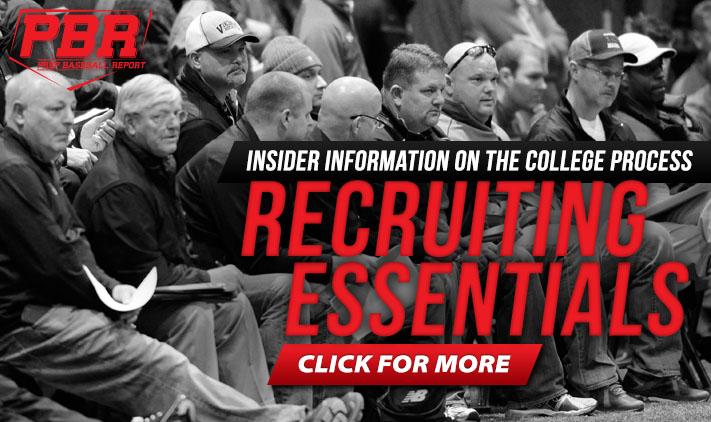Recruiting Essentials: The Re-Boot
March 15, 2017

By Brandon Hall
North Carolina Scouting Director
Families and players are at a distinct disadvantage when compared to college coaches in dealing with the recruiting process. College coaches live the recruiting process. For years upon years, their livelihood is based on their ability to know the rules, understand the process, and land incoming players that will make their program better. On the other hand, players and parents may become experts on the recruiting process, but most of the time that “black-belt” is earned through trial and error and after the decision process is complete.
In the coming weeks and months, Prep Baseball Report is re-booting a very popular segment to help players and parents understand the recruiting process, and how to attack their decision process. In 2014-2015, PBR ran Recruiting Essentials as a weekly column talking about the NCAA rules, the coaches process, the player's process, do’s and don’ts, and even a question and answer segment. As the NCAA continues to grow, and as the world continues to evolve and change (see smart phones and social media), rules have been altered. In the two short years since Recruiting Essentials went on hiatus, the NCAA has completely revamped the way schools can work with recruits and their own players once they are on campus.
We are now re-booting Recruiting Essentials to give the players and families a place to learn and ask questions.
Topics and areas that we will cover include, but are not limited to:
+ NCAA Rules at the Division I, II, and III levels as they pertain to college baseball
+ Understanding Academic criteria of the NCAA and individual institutions
+ Communicating with college coaches
+ Understanding your Social Media imprint
+ Transfers – Process, Issues, 4-2-4 & 2-4 Transfers
+ College Baseball vs. Professional Baseball
+ Question and Answer sessions: We will address specific questions or concerns
Next week we will jump in with both feet very quickly to some of the nuts and bolts of the recruiting process. We will talk about how coaches go about building their rosters… how do they manage their scholarships… why do they recruit the way they do. The hope is that understanding how a college coach is working to get to their roster, it will give players and families a better understanding of the communication they are receiving. In order to look ahead, you have a little bit of homework – I know… homework on the first day, but it will be worth it… Simply fill out a baseball roster, at the Division I level, by position with the following rules:
+ 35 Players on the roster
+ 27 of the Players are allowed to be on Baseball Scholarship, or Aid
+ Of the 27 Players Baseball Aid, the lowest any of them can receive is a 25% scholarship
+ You have a total of 11.7 Scholarships to divide between a maximum of 27 players
+ A typical roster will carry anywhere from 13 – 20 pitchers… You can have players that pitch and play a position, but be warned it is very difficult to do both.
It helps to fill the roster out on a diamond, so you can see where you are spending your money and where the roster may be deficient. Run with that scenario this week and we will look to see how you did in next week’s Recruiting Essentials.
ABOUT BRANDON HALL
Prior to becoming the PBR North Carolina Scouting Director, Hall spent 18 years coaching at the Division I level in North Carolina. Raised in Raleigh, Hall coached 14 years at UNC Charlotte, including seven years as associate head coach and 11 seasons as the recruiting coordinator. Prior to joining the coaching staff at Charlotte, Hall spent four seasons as an assistant coach at his alma mater, UNC Wilmington, where he also worked with the pitchers. In his 18 seasons as an assistant at the two schools, Hall's teams have won eight regular-season championships and seven of his pitching staffs have been ranked nationally in ERA, including the top spot in the nation in 2007 (at 2.64).
Recent News
